 Islamic Empire
Islamic Empire

(Text by Duane R. Hurst © 2013)
Click on a link to view its information and pictures.
|
ISLAM LINKS: Significant Event: Kabaa in Mecca Main Cities: Jerusalem; Mecca; Riyadh Time: 900-1600 AD Language: Arabic Personage: Muhammad Religion: Islam Religion Related Country: Saudi Arabia |
|
|
Brief History: I have included only a few items concerning the history of this empire. A good source for more details can be found on Wikipedia or in history books. EARLY YEARS: Muhammad was a leader of the Banu Hashim tribe (Quraysh clan). The Quraysh were guardians of the Kabaa in Mecca. In 610 AD, Muhammad became a prophet who reported receiving personal revelation at age 40 from God through the angel Gabriel. These revelations and others were compiled in the Qur'an (holy book of Islam). In 622 AD, Muhammad and his father-in-law, Abu Bakr, escaped an assassination attempt. They and Muhammad's followers made a hijra (migration or journey) from Mecca to Yathrib (modern Medina). Blood feuds, previously common among the Arabs, became less frequent under Islam. Muhammad initiated a 10-year truce (Treaty of Hudaybiyyah) between Medina and the Quraish tribe of Mecca in 628 AD. Muhammad's followers made the First Pilgrimage back to Mecca in 629 AD. Muslims conquered Mecca in 630 AD and Muhammad died in June 632 AD. RISING EMPIRE: In December 632 AD, Abu Bakr became the first Muslim Caliph and defeated Musaylimah (a self-styled false prophet) and his army in the Battle of Yamama -- part of the Ridda Wars. Abu Bakr later ruled the Rashidun Caliphate (632-634 AD). Other "Rashidun" (rightly guided) caliphs who oversaw the rapid spread of Islam were: Umar ibn al-Khattab (634-644 AD), Uthman ibn Affan (644-656 AD), and Ali ibn Abi Talib (656-661 AD). Umar lived in a mud hut to ascertain the needs of poor people, and instituted the Bayt al-mal (House of Wealth) to provide welfare assistance. He also introduced benefits and pensions for needy children and the elderly. During his reign, Islamic forces conquered Egypt and the Sassanid Empire. The Qur'an also was standardized. In 644 AD, assassins killed Umar. Many indigenous people aided Muslims to overthrow Byzantines and Sassanids, which helped spread Islamic faith and dominion. The Arab-Byzantine wars (629-1050s AD) were sanguinary and eventually ended when Muslim troops breached the Theodosian Walls and ended the Siege of Constantinople in 1453 AD. Mehmed II led the Ottoman host and directed use of large cannons to pound city walls. EXPANSION IN NORTH AFRICA AND SPAIN: In 682 AD, General Uqba ibn Nafi conquered much of northern Africa from the Byzantines and Berbers. Ten years later Muslims soundly defeated Byzantine forces at the Battle of Sebastopolis in Turkey. Between 711 and 712 AD, Muslim Berbers under Tariq ibn Ziyad invaded Visigothic Hispania and triumphed at the Battle of Guadalete. Muslims continued to capture Hispania and Portugal. However, their attempt to seize land from the Franks was stopped at the Battle of Poitiers/Tours in 732 AD. GOLDEN AGE: In 750 AD, the Abbasid Dynasty seized power. They captured the Baleares and Sicily. They also fostered architecture, inventions, mathematics and science. They erected great buildings such as the Alhambra in Spain, Dome of the Rock at Jerusalem and the Djenné Mosque in Mali. The capital was moved to Baghdad, which became one of the world's largest cities. Caliph Al-Mutawakkil (847-861 AD) ruled during Muslim's Golden Age and built the Great Mosque of Samarra. CRUSADES: Between 1095 and 1272 AD, Christian states in Europe staged a series of religious crusades to attack Islam, particularly in the "Holy Land" of Israel. In 1095 AD, Pope Urban II urged a First Crusade against Muslim control of Jerusalem and other sites. Soldiers successfully formed a Kingdom of Jerusalem (1099-1291 AD) and strongholds such as Krak des Chevaliers. King Richard I conquered Cyprus and executed 3,000 Islamic prisoners at Acre. Richard defeated the army of Sultan Salah ad-Din (aka Saladin) at the Battle of Arsuf. Salah ad-Din destroyed a Christian army at the Battle of Hattin in 1187 AD. Salah ad-Din also founded the Ayyubid Dynasty in 1174 AD. DECLINE: Abbasid rule declined after the death of Al-Mutawakkil and devolved into regional states by 1180 AD. The Fatimid Caliphate (909-1171 AD) ruled much of the former Abbasid territory. Islam's Golden Age ended with Mongol invasions that started in 1219 AD. Baghdad fell in 1258 AD to the army of Hulagu Khan, that slaughtered a minimum of 90,000 people. In 1250 AD, Mamluks in Egypt overthrew the Ayyubids and defeated Mongol invaders in the Battle of Ain Jalut. Despite such setbacks, Islam continued to spread throughout Africa and Asia, exemplified in the Mughal Empire (1526-1857 AD) of India. Its greatest example of architecture was the Taj Mahal. |
|
|
© Page Publisher: Duane R. Hurst
|


